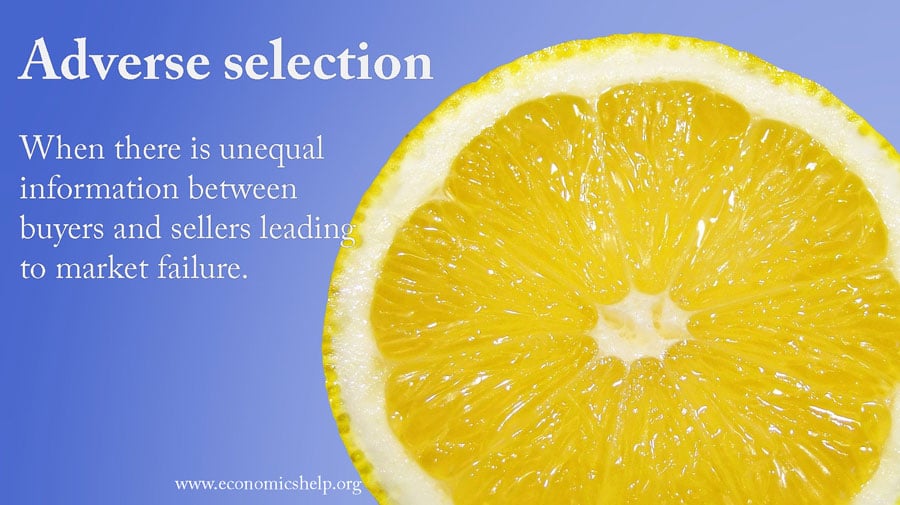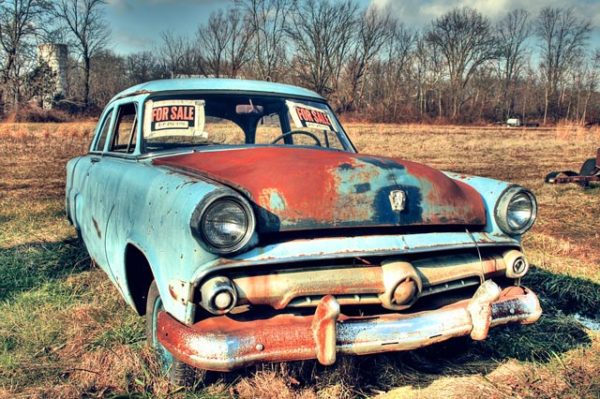Definition of adverse selection
Adverse selection occurs when there is asymmetric (unequal) information between buyers and sellers. This unequal information distorts the market and leads to market failure.
- For example, buyers of insurance may have better information than sellers. Those who want to buy insurance are those most likely to make a claim. Therefore firms are reluctant to sell insurance.
- Sellers of second-hand goods may have better information about the true quality of the good than buyers. Therefore, buyers are reluctant to pay a decent price because they fear getting a ‘dud’.
Adverse selection occurs because of information asymmetries and the difficulties in selecting customers.
Adverse selection explained for insurance
- A company selling life insurance will find that people at higher risk of death will be much more willing to want to buy life insurance. If the insurance company charges an average price, but only high-risk consumers buy – they will make a loss.
- If a company selling life insurance sells at a high price to take account of the high-risk people, then young, healthy people will not buy. Because the cost is greater than their perceived value.
- A company insuring cars will find those living in high crime areas will be more likely to want to get car insurance. Again if the average cost is charged, it can lead to insurance firm losing out.
Consequences of adverse selection
- Due to poor information and difficulty selecting customers, there will be a higher overall price as firms have to take into account relatively higher payouts to high-risk customers taking out insurance.
- Low-risk customers may not want to buy because it istoo expensive for their needs – leading to a missing market.
- Firms may invest considerable time in identifying which groups of consumers are higher risk.
Adverse selection in health insurance
Suppose an insurance firm offered health insurance to the general public. It is likely to have the highest take-up rate amongst unhealthy people – people who don’t exercise, people who smoke. They are the group most likely to need health care; therefore, it makes sense for them to take out insurance. Healthy people are less likely to take out health insurance – if the price of health insurance is determined by the average unhealthy person.
If insurance premiums are based on the needs of smokers, then the premiums will be high. Therefore, there is no incentive for healthy people to take out insurance.
Adverse selection for buyers
It is also possible that the seller will have better information than buyers, and sellers only sell the product when it is favourable to them.
- For example, managers of a company may be more willing to issue shares, when they know the share price is overvalued compared to real value. Therefore, buyers can end up buying over-valued shares.
- Another example is the second-hand car market. The seller may know about an invisible defect and charge too much to a consumer who is badly informed. This can lead to a situation wherein second-hand car markets, people most willing to sell are those with bad cars (lemons). If you have a good car (peach) you don’t want to sell because the average market price is depressed by the number of lemons (bad cars) on the market.
Solutions to adverse selection
To avoid adverse selection, firms need to try and identify different groups of people. This is why there are health insurance premiums for people who smoke and obese people.
Insurance firms will charge different rates to consumers depending on factors, such as
- Age
- Postcode.
This means that those who are at most risk will likely have higher premium rates.
Compulsory purchase
American health care is primarily based on private insurance. This has led to problems of adverse selection, with young, healthy people more likely to avoid taking out health insurance. This led to higher overall premiums – making it unaffordable for many.
One element of the Affordable Health Care act was to have a compulsory insurance element. If people choose not to take out insurance, they have to pay a tax premium. The idea is that by encouraging people to purchase, it will lower overall premiums as people with lower-risk will join the ‘insurance pool.’
Economists and adverse selection
George Akerlof investigated the asymmetry of information in the market for second-hand cars.
In a 1970 paper “The Market for Lemons,” he was awarded the Nobel Prize in Economics (2001). Akerlof suggested bad cars ‘lemons’ were more likely to be put onto the second-hand market, reducing the price. Therefore good cars were held back and not sold. It is sometimes known as the ‘bad driving out the good.’
Akerlof suggested the problem of adverse selection distorted the market, leading to lower prices and the lower average quality of cars.
Others have suggested the second-hand car market can try to use warranties and quality controls to overcome this problem of poor information.
Related


